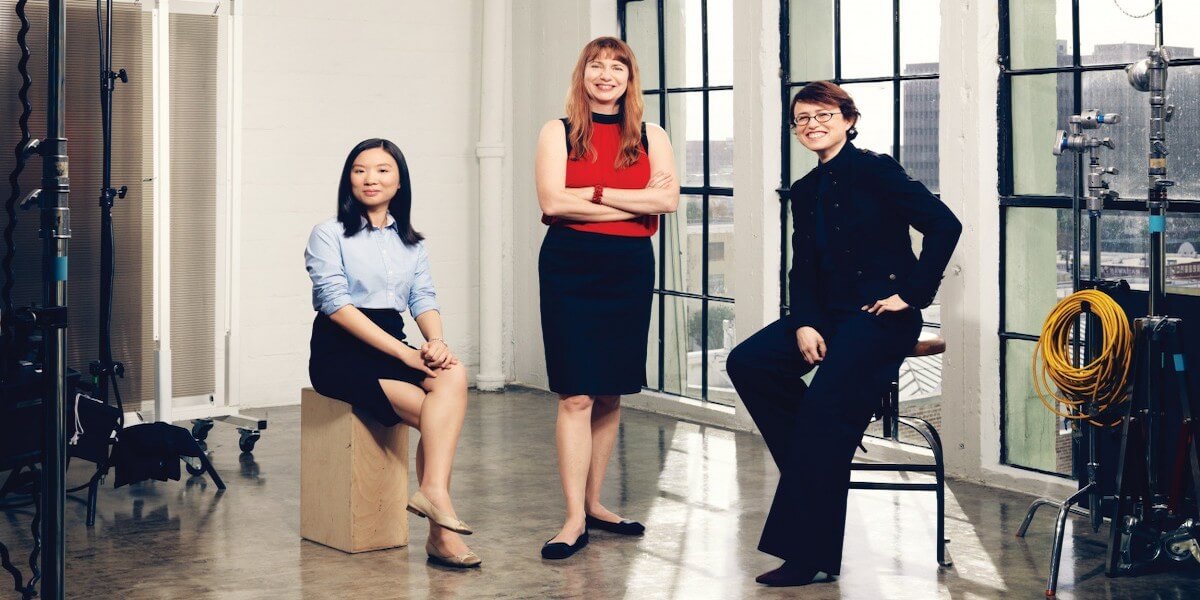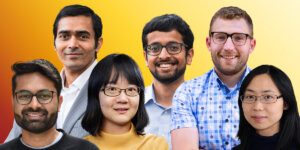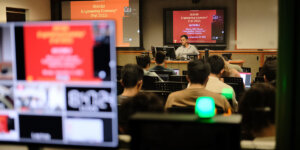
Ruyan Chen ’16, left, alongside some of her mentors, engineering professors Maja Matarić, center, and Leana Golubchik, Stephen and Etta Varra professor of computer science and electrical and computer engineering, right. (PHOTO/CODY PICKENS)
The average USC undergraduate student — bold, impactful and passionate — turned 20 years old in 2020.
This year also saw the 20th anniversary of another integral part of the USC Trojan Family: not a single student, but rather the collection of students, faculty, staff, and initiatives that make up the USC Women in Science and Engineering (WiSE) program, a USC Provost Office collaboration with eligible departments in the USC Viterbi School of Engineering and the USC Dornsife College of Letters, Arts, and Sciences.
On Oct 26 to Oct. 30, USC WiSE faculty and alumnae hosted a series of virtual events, including talks, panels, networking mixers and even yoga sessions for the USC community to partake in the celebration.
Perhaps the most inspiring of events was the “Origins of WiSE” panel featuring seven WiSE women: USC biological sciences professors Suzanne Edmands, Jill McNitt-Gray and Lorraine Turcotte; chemistry professors Anna Krylov and Hanna Reisler; Maja Matarić, USC Viterbi computer science professor; and Susan Montgomery, professor of mathematics — whose testimonies and reflections on the invaluable support and inspiration they received from being a part of WiSE kicked of the week long festivities.
“It’s an honor to speak about the tremendous impact WiSE has had on the women in our community 20 years later alongside one of my first mentors at USC — Dr. Reisler,” said Matarić, the Chan Soon-Shiong Professor of Computer Science, Neuroscience and Pediatrics. Matarić, a pioneer in socially assistive robotics, has since paid it forward, having mentored countless women scientists and roboticists through her research in the USC Interaction Lab.
“I knew that I could help other women do it because I saw Dr. Reisler doing it, too,” she added.
Reisler, a pioneer of the WiSE program, was one of three tenured or tenured-track women faculty at USC Viterbi and 12 at USC Dornsife when, in 2000, an anonymous donor gave $20 million to increase the representation of women in science and engineering at the university.
“This gift was a direct investment in the future of science and engineering at USC and in the world,” Reisler said. “I remember gathering some of the other women faculty who knew this was our chance to do something transformative.”
Thus, the WiSE program was born. The small, but mightily brilliant group of women got to work immediately, advising the university on what kinds of initiatives should be supported by the generous donation. The first? An effort to increase the number of women in science and engineering faculty positions at USC.
“Women in academia face a unique set of challenges and experiences compared to their male counterparts. The only way to make these experiences more visible and common is to hire more women,” said Krylov, the Gabilan Distinguished Professor in Science and Engineering, who retold the story of one of her mentees who was inspired to continue her doctoral pursuits despite unexpected motherhood after attending a distinguished lecture by a math professor who brought her young child to the presentation.
Today, the number of USC Viterbi women tenured and tenure track faculty is more than tenfold what is was two decades ago — from three to 37. The school now has 69 full-time, women faculty members.
On top of assisting USC Viterbi and USC Dornsife academic departments with recruiting some of the finest talent in the STEM fields, the WiSE program funds grants that further support women in science and engineering and ensure none of the challenges they face are barriers to their success, including: undergraduate research grants, travel grants, supplemental research support, child care subsidiaries, and fellowships to accommodate pregnancy, childbirth and adoption for Ph.D. students and postdoctoral scholars.
It may not have been easy, but over the past two decades, WiSE laid the foundation for women scientists and engineers in academia to feel seen and supported. While many of the “Origins of WiSE” panelists agree that there is still much to accomplish to further the impact of WiSE, they are excited to see what the next 20 years have in store.
Today in 2020, however, the vision for the WiSE program to increase the representation of women in science and engineering is as crystal clear as it was during its inception, and that is something to celebrate.
Published on November 12th, 2020
Last updated on April 8th, 2021










